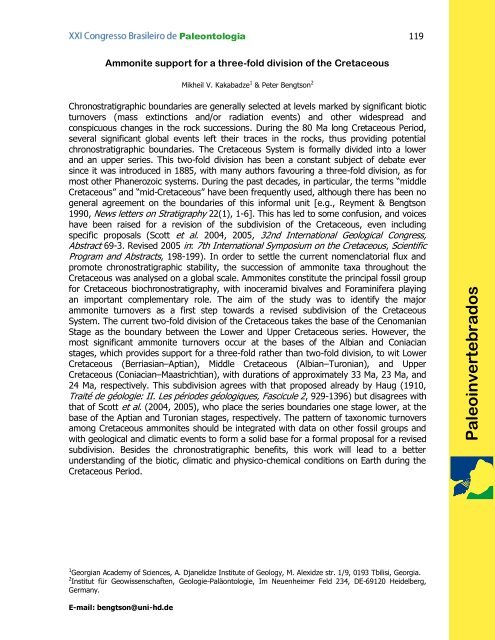Livro de Resumos - Dinossauros do Maranhão
Livro de Resumos - Dinossauros do Maranhão
Livro de Resumos - Dinossauros do Maranhão
Create successful ePaper yourself
Turn your PDF publications into a flip-book with our unique Google optimized e-Paper software.
Paleontologia 119<br />
1 Georgian Aca<strong>de</strong>my of Sciences, A. Djanelidze Institute of Geology, M. Alexidze str. 1/9, 0193 Tbilisi, Georgia.<br />
2 Institut für Geowissenschaften, Geologie-Paläontologie, Im Neuenheimer Feld 234, DE-69120 Hei<strong>de</strong>lberg,<br />
Germany.<br />
Ammonite support for a three-fold division of the Cretaceous<br />
E-mail: bengtson@uni-hd.<strong>de</strong><br />
Mikheil V. Kakabadze 1 & Peter Bengtson 2<br />
Chronostratigraphic boundaries are generally selected at levels marked by significant biotic<br />
turnovers (mass extinctions and/or radiation events) and other wi<strong>de</strong>spread and<br />
conspicuous changes in the rock successions. During the 80 Ma long Cretaceous Period,<br />
several significant global events left their traces in the rocks, thus providing potential<br />
chronostratigraphic boundaries. The Cretaceous System is formally divi<strong>de</strong>d into a lower<br />
and an upper series. This two-fold division has been a constant subject of <strong>de</strong>bate ever<br />
since it was introduced in 1885, with many authors favouring a three-fold division, as for<br />
most other Phanerozoic systems. During the past <strong>de</strong>ca<strong>de</strong>s, in particular, the terms “middle<br />
Cretaceous” and “mid-Cretaceous” have been frequently used, although there has been no<br />
general agreement on the boundaries of this informal unit [e.g., Reyment & Bengtson<br />
1990, News letters on Stratigraphy 22(1), 1-6]. This has led to some confusion, and voices<br />
have been raised for a revision of the subdivision of the Cretaceous, even including<br />
specific proposals (Scott et al. 2004, 2005, 32nd International Geological Congress,<br />
Abstract 69-3. Revised 2005 in: 7th International Symposium on the Cretaceous, Scientific<br />
Program and Abstracts, 198-199). In or<strong>de</strong>r to settle the current nomenclatorial flux and<br />
promote chronostratigraphic stability, the succession of ammonite taxa throughout the<br />
Cretaceous was analysed on a global scale. Ammonites constitute the principal fossil group<br />
for Cretaceous biochronostratigraphy, with inoceramid bivalves and Foraminifera playing<br />
an important complementary role. The aim of the study was to i<strong>de</strong>ntify the major<br />
ammonite turnovers as a first step towards a revised subdivision of the Cretaceous<br />
System. The current two-fold division of the Cretaceous takes the base of the Cenomanian<br />
Stage as the boundary between the Lower and Upper Cretaceous series. However, the<br />
most significant ammonite turnovers occur at the bases of the Albian and Coniacian<br />
stages, which provi<strong>de</strong>s support for a three-fold rather than two-fold division, to wit Lower<br />
Cretaceous (Berriasian–Aptian), Middle Cretaceous (Albian–Turonian), and Upper<br />
Cretaceous (Coniacian–Maastrichtian), with durations of approximately 33 Ma, 23 Ma, and<br />
24 Ma, respectively. This subdivision agrees with that proposed already by Haug (1910,<br />
Traité <strong>de</strong> géologie: II. Les pério<strong>de</strong>s géologiques, Fascicule 2, 929-1396) but disagrees with<br />
that of Scott et al. (2004, 2005), who place the series boundaries one stage lower, at the<br />
base of the Aptian and Turonian stages, respectively. The pattern of taxonomic turnovers<br />
among Cretaceous ammonites should be integrated with data on other fossil groups and<br />
with geological and climatic events to form a solid base for a formal proposal for a revised<br />
subdivision. Besi<strong>de</strong>s the chronostratigraphic benefits, this work will lead to a better<br />
un<strong>de</strong>rstanding of the biotic, climatic and physico-chemical conditions on Earth during the<br />
Cretaceous Period.<br />
Paleoinvertebra<strong>do</strong>s


